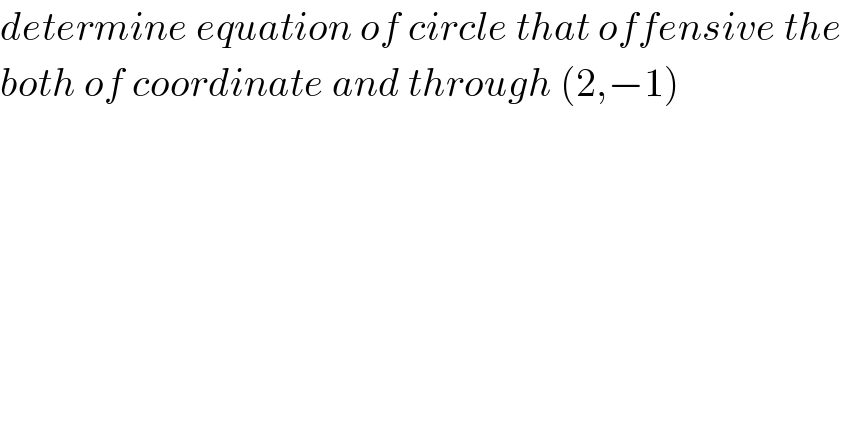
Question Number 5998 by Kasih last updated on 09/Jun/16

$${determine}\:{equation}\:{of}\:{circle}\:{that}\:{offensive}\:{the} \\ $$$${both}\:{of}\:{coordinate}\:{and}\:{through}\:\left(\mathrm{2},−\mathrm{1}\right) \\ $$
Commented by Rasheed Soomro last updated on 09/Jun/16

$${What}\:{do}\:{you}\:{mean}\:{by}\:``{offensive}''? \\ $$
Commented by Kasih last updated on 09/Jun/16

$${i}\:{don}'{t}\:{know}.\:{maybe}\:{offend},\:{treat},\:{touch},\:{or}\:{pass}. \\ $$$${sorry}\:{i}\:{can}'{t}\:{use}\:{english}\:{language}\:{well} \\ $$
Commented by FilupSmith last updated on 09/Jun/16

$$\mathrm{Assumed}\:\mathrm{Correction}: \\ $$$$\mathrm{Determin}\:\mathrm{the}\:\mathrm{equation}\:\mathrm{of}\:\mathrm{the}\:\mathrm{circle} \\ $$$$\mathrm{that}\:\mathrm{passes}\:\mathrm{through}\:\mathrm{the}\:\mathrm{coordinate} \\ $$$$\left(\mathrm{2},\:−\mathrm{1}\right) \\ $$
Commented by Kasih last updated on 09/Jun/16

$${and}\:{pass}\:{through}\:{the}\:{both}\:{axis}\:{in}\:{cartrsian}\:{coordinate} \\ $$
Commented by prakash jain last updated on 09/Jun/16

$$\mathrm{Mostly}\:\mathrm{the}\:\mathrm{question}\:\mathrm{might}\:\mathrm{be}\:\mathrm{2}\:\mathrm{axis}\:\mathrm{as}\:\mathrm{tangent} \\ $$$$\mathrm{and}\:\mathrm{passing}\:\mathrm{thru}\:\mathrm{the}\:\mathrm{given}\:\mathrm{point}. \\ $$
Answered by Rasheed Soomro last updated on 10/Jun/16
![•The center of the circle which touches both axes is equidistant from the axes. •Also if the circle is tangent to both axes, it is limeted to one quardant only. • Since it passes through (2,−1) that means the circle is in fourth quardant. •Let h is the directed distance of the centre from x-axis. Then the directed distance of the center from y-axis is −h. [y-coordinate is negative in fourth quardant] •The radius of the circle is ∣ h∣. Hence the equation of such circle will be: (x−h)^2 +( y−(−h) )^2 =∣h∣^2 As this circle passes through (2,−1), the equation will be satisfied by (x,y)=(2,−1): (2−h)^2 +(−1+h)^2 =h^2 ∵ ∣h∣^2 =h^2 4−4h+h^2 +1−2h+h^2 −h^2 =0 h^2 −6h+5=0 (h−1)(h−5)=0 h=1 ∨ h=5 The equation of the required circle is (x−1)^2 +(y+1)^2 =1 Or (x−5)^2 +(y+5)^2 =25](Q6029.png)
$$\bullet{The}\:{center}\:{of}\:{the}\:{circle}\:{which}\:{touches} \\ $$$${both}\:{axes}\:{is}\:{equidistant}\:{from}\:{the}\:{axes}. \\ $$$$ \\ $$$$\bullet{Also}\:{if}\:{the}\:{circle}\:{is}\:{tangent}\:{to}\:{both}\:{axes}, \\ $$$${it}\:{is}\:{limeted}\:{to}\:{one}\:{quardant}\:{only}. \\ $$$$\bullet\:{Since}\:{it}\:{passes}\:{through}\:\left(\mathrm{2},−\mathrm{1}\right)\:{that}\:{means}\:{the} \\ $$$${circle}\:{is}\:{in}\:{fourth}\:{quardant}. \\ $$$$ \\ $$$$\bullet{Let}\:\:{h}\:\:{is}\:\:{the}\:{directed}\:\:{distance}\:{of}\:{the}\:\:{centre}\:{from}\: \\ $$$${x}-{axis}.\:{Then}\:\:{the}\:{directed}\:{distance}\:{of}\:{the}\:{center} \\ $$$${from}\:{y}-{axis}\:{is}\:\:\:−{h}.\:\left[{y}-{coordinate}\:{is}\:{negative}\:{in}\right. \\ $$$$\left.{fourth}\:{quardant}\right] \\ $$$$\bullet{The}\:\:{radius}\:{of}\:{the}\:{circle}\:{is}\:\:\mid\:{h}\mid. \\ $$$$ \\ $$$${Hence}\:{the}\:{equation}\:{of}\:{such}\:{circle}\:{will}\:{be}: \\ $$$$\:\:\:\:\:\:\:\:\:\:\:\:\:\left({x}−{h}\right)^{\mathrm{2}} +\left(\:{y}−\left(−{h}\right)\:\right)^{\mathrm{2}} =\mid{h}\mid^{\mathrm{2}} \\ $$$${As}\:{this}\:{circle}\:{passes}\:{through}\:\left(\mathrm{2},−\mathrm{1}\right),\:{the} \\ $$$${equation}\:\:{will}\:{be}\:{satisfied}\:{by}\:\left({x},{y}\right)=\left(\mathrm{2},−\mathrm{1}\right): \\ $$$$\:\:\:\:\:\:\:\:\:\:\:\:\:\:\:\:\:\:\:\left(\mathrm{2}−{h}\right)^{\mathrm{2}} +\left(−\mathrm{1}+{h}\right)^{\mathrm{2}} ={h}^{\mathrm{2}} \:\:\:\:\:\because\:\mid{h}\mid^{\mathrm{2}} ={h}^{\mathrm{2}} \\ $$$$\:\:\:\:\:\:\:\:\:\:\:\:\:\:\:\:\mathrm{4}−\mathrm{4}{h}+{h}^{\mathrm{2}} +\mathrm{1}−\mathrm{2}{h}+{h}^{\mathrm{2}} −{h}^{\mathrm{2}} =\mathrm{0} \\ $$$$\:\:\:\:\:\:\:\:\:\:\:\:\:\:\:\:{h}^{\mathrm{2}} −\mathrm{6}{h}+\mathrm{5}=\mathrm{0} \\ $$$$\:\:\:\:\:\:\:\:\:\:\:\:\:\:\:\:\left({h}−\mathrm{1}\right)\left({h}−\mathrm{5}\right)=\mathrm{0} \\ $$$$\:\:\:\:\:\:\:\:\:\:\:\:\:\:\:\:\:{h}=\mathrm{1}\:\:\vee\:\:{h}=\mathrm{5} \\ $$$${The}\:{equation}\:{of}\:{the}\:{required}\:{circle}\:{is} \\ $$$$\:\:\:\:\:\:\:\:\:\:\:\:\:\:\:\:\:\left({x}−\mathrm{1}\right)^{\mathrm{2}} +\left({y}+\mathrm{1}\right)^{\mathrm{2}} =\mathrm{1} \\ $$$$\:{Or}\:\:\:\:\:\:\:\:\:\:\:\left({x}−\mathrm{5}\right)^{\mathrm{2}} +\left({y}+\mathrm{5}\right)^{\mathrm{2}} =\mathrm{25} \\ $$$$ \\ $$
Commented by Rasheed Soomro last updated on 10/Jun/16

Commented by Rasheed Soomro last updated on 10/Jun/16

Commented by Kasih last updated on 10/Jun/16

$${thank}\:{you} \\ $$
